Kedison PLC Financial Statement Analysis: Ratios and Interpretation
VerifiedAdded on 2023/06/18
|15
|1989
|423
Report
AI Summary
This report provides a detailed analysis of Kedison PLC's financial statements, including the preparation of a profit and loss statement and a statement of financial position for the year ended 31st December 2020. It covers key aspects such as sales, cost of sales, administrative expenses, interest paid, and tax implications to arrive at net profit and retained earnings. The report also includes working notes explaining specific accounting treatments, such as interest expense calculation, sales commission recording, and dividend payments. Furthermore, it discusses the reasons for balancing the statement of financial position, emphasizing the adherence to the accounting equation and the double-entry system. In addition, the report calculates and interprets various financial ratios for Chocco plc, including ROCE, ROE, earnings per share, net profit margin, asset turnover, stock holding days, debtors collection period, current ratio, gearing ratio, and inventory turnover ratio. The interpretation of these ratios provides insights into the company's profitability, efficiency, and liquidity, comparing the performance between 2019 and 2020. Desklib offers a platform to explore similar financial analysis reports and solved assignments for students.
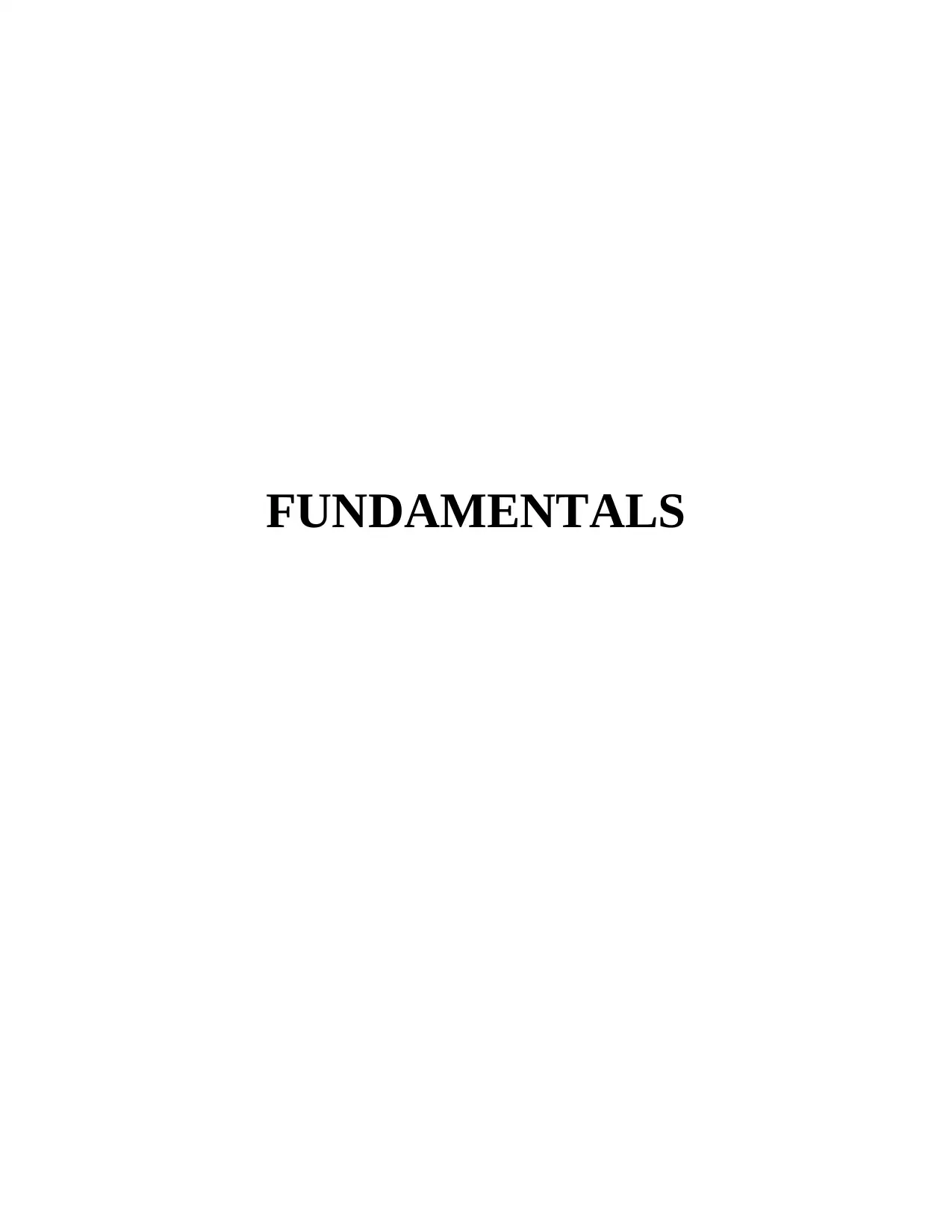
FUNDAMENTALS
Paraphrase This Document
Need a fresh take? Get an instant paraphrase of this document with our AI Paraphraser
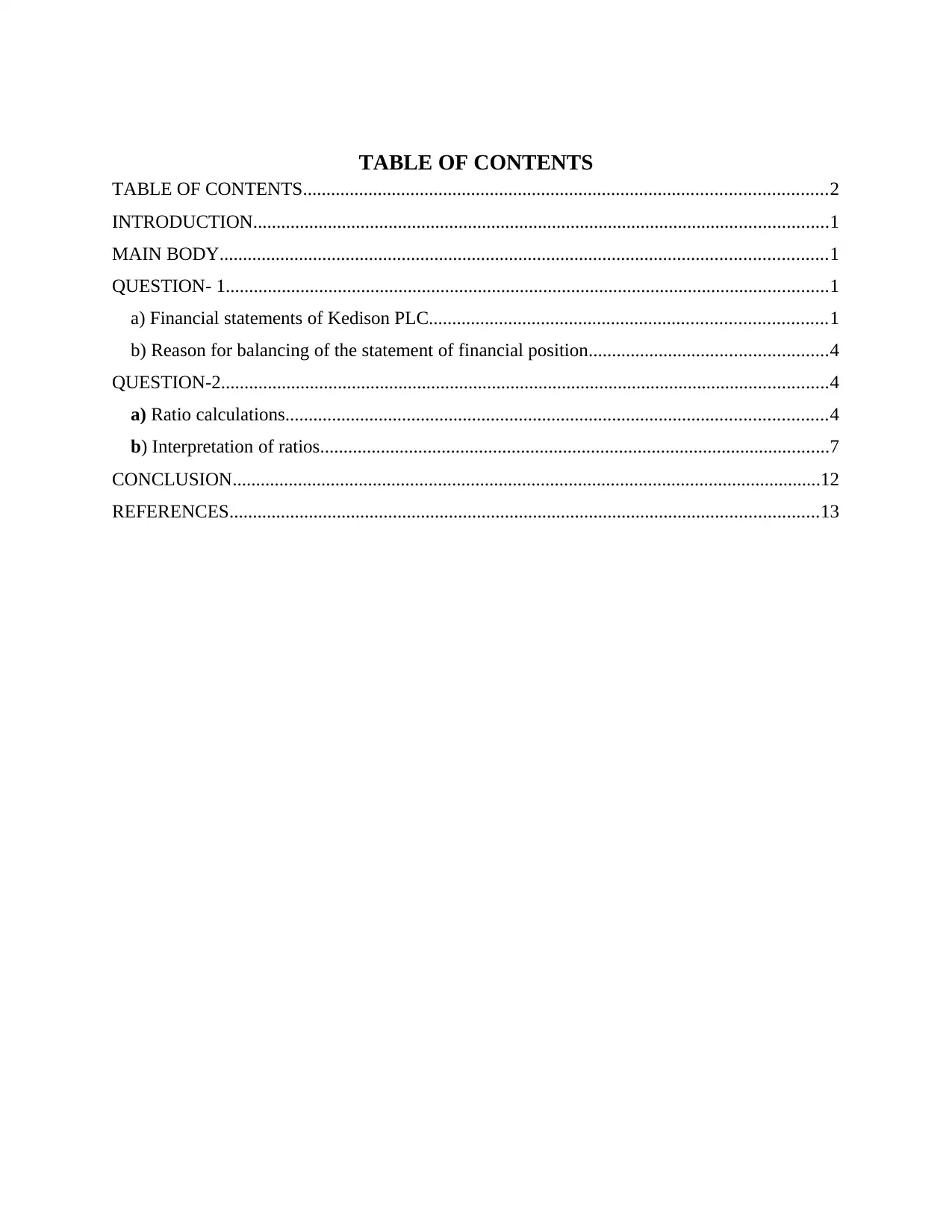
TABLE OF CONTENTS
TABLE OF CONTENTS................................................................................................................2
INTRODUCTION...........................................................................................................................1
MAIN BODY..................................................................................................................................1
QUESTION- 1.................................................................................................................................1
a) Financial statements of Kedison PLC.....................................................................................1
b) Reason for balancing of the statement of financial position...................................................4
QUESTION-2..................................................................................................................................4
a) Ratio calculations....................................................................................................................4
b) Interpretation of ratios.............................................................................................................7
CONCLUSION..............................................................................................................................12
REFERENCES..............................................................................................................................13
TABLE OF CONTENTS................................................................................................................2
INTRODUCTION...........................................................................................................................1
MAIN BODY..................................................................................................................................1
QUESTION- 1.................................................................................................................................1
a) Financial statements of Kedison PLC.....................................................................................1
b) Reason for balancing of the statement of financial position...................................................4
QUESTION-2..................................................................................................................................4
a) Ratio calculations....................................................................................................................4
b) Interpretation of ratios.............................................................................................................7
CONCLUSION..............................................................................................................................12
REFERENCES..............................................................................................................................13
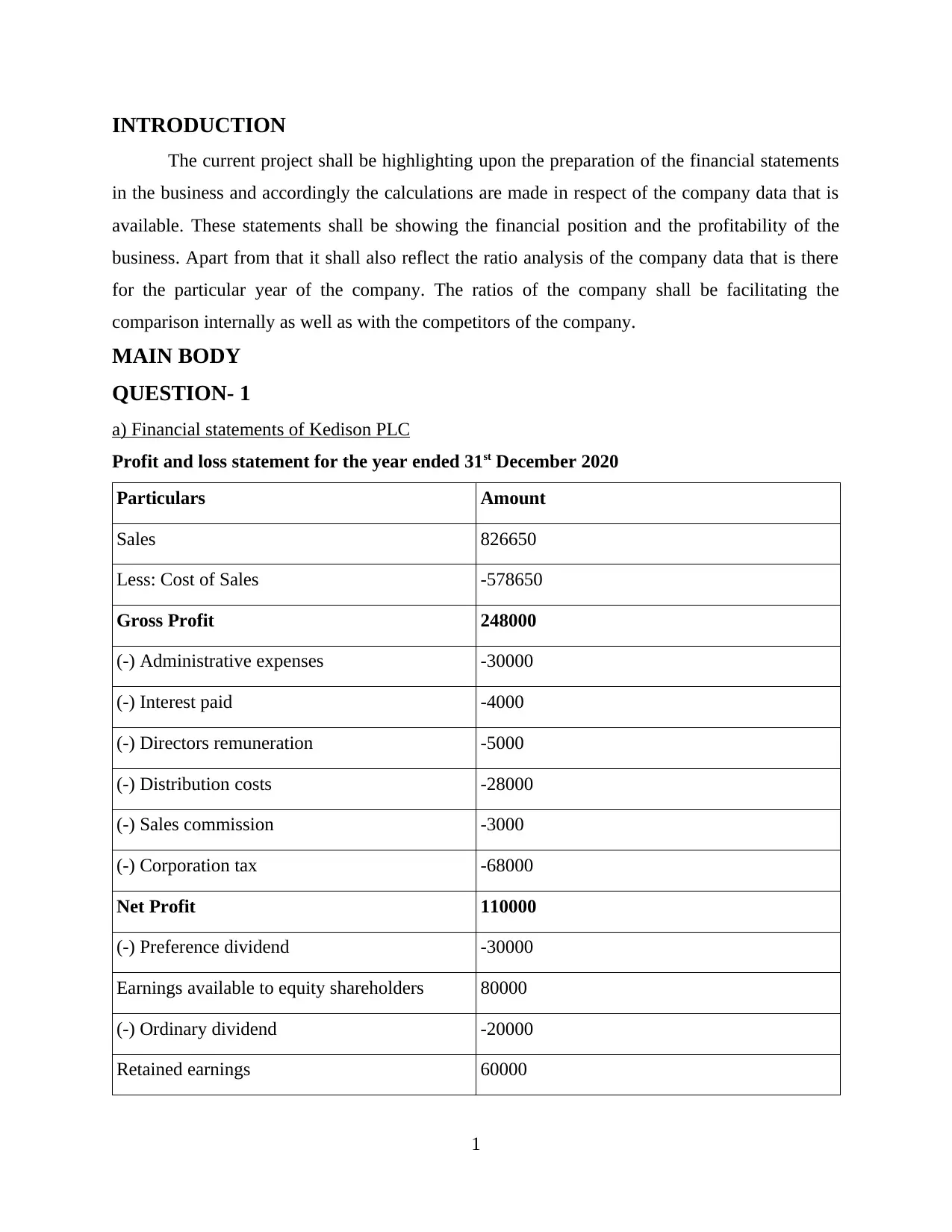
INTRODUCTION
The current project shall be highlighting upon the preparation of the financial statements
in the business and accordingly the calculations are made in respect of the company data that is
available. These statements shall be showing the financial position and the profitability of the
business. Apart from that it shall also reflect the ratio analysis of the company data that is there
for the particular year of the company. The ratios of the company shall be facilitating the
comparison internally as well as with the competitors of the company.
MAIN BODY
QUESTION- 1
a) Financial statements of Kedison PLC
Profit and loss statement for the year ended 31st December 2020
Particulars Amount
Sales 826650
Less: Cost of Sales -578650
Gross Profit 248000
(-) Administrative expenses -30000
(-) Interest paid -4000
(-) Directors remuneration -5000
(-) Distribution costs -28000
(-) Sales commission -3000
(-) Corporation tax -68000
Net Profit 110000
(-) Preference dividend -30000
Earnings available to equity shareholders 80000
(-) Ordinary dividend -20000
Retained earnings 60000
1
The current project shall be highlighting upon the preparation of the financial statements
in the business and accordingly the calculations are made in respect of the company data that is
available. These statements shall be showing the financial position and the profitability of the
business. Apart from that it shall also reflect the ratio analysis of the company data that is there
for the particular year of the company. The ratios of the company shall be facilitating the
comparison internally as well as with the competitors of the company.
MAIN BODY
QUESTION- 1
a) Financial statements of Kedison PLC
Profit and loss statement for the year ended 31st December 2020
Particulars Amount
Sales 826650
Less: Cost of Sales -578650
Gross Profit 248000
(-) Administrative expenses -30000
(-) Interest paid -4000
(-) Directors remuneration -5000
(-) Distribution costs -28000
(-) Sales commission -3000
(-) Corporation tax -68000
Net Profit 110000
(-) Preference dividend -30000
Earnings available to equity shareholders 80000
(-) Ordinary dividend -20000
Retained earnings 60000
1
⊘ This is a preview!⊘
Do you want full access?
Subscribe today to unlock all pages.

Trusted by 1+ million students worldwide
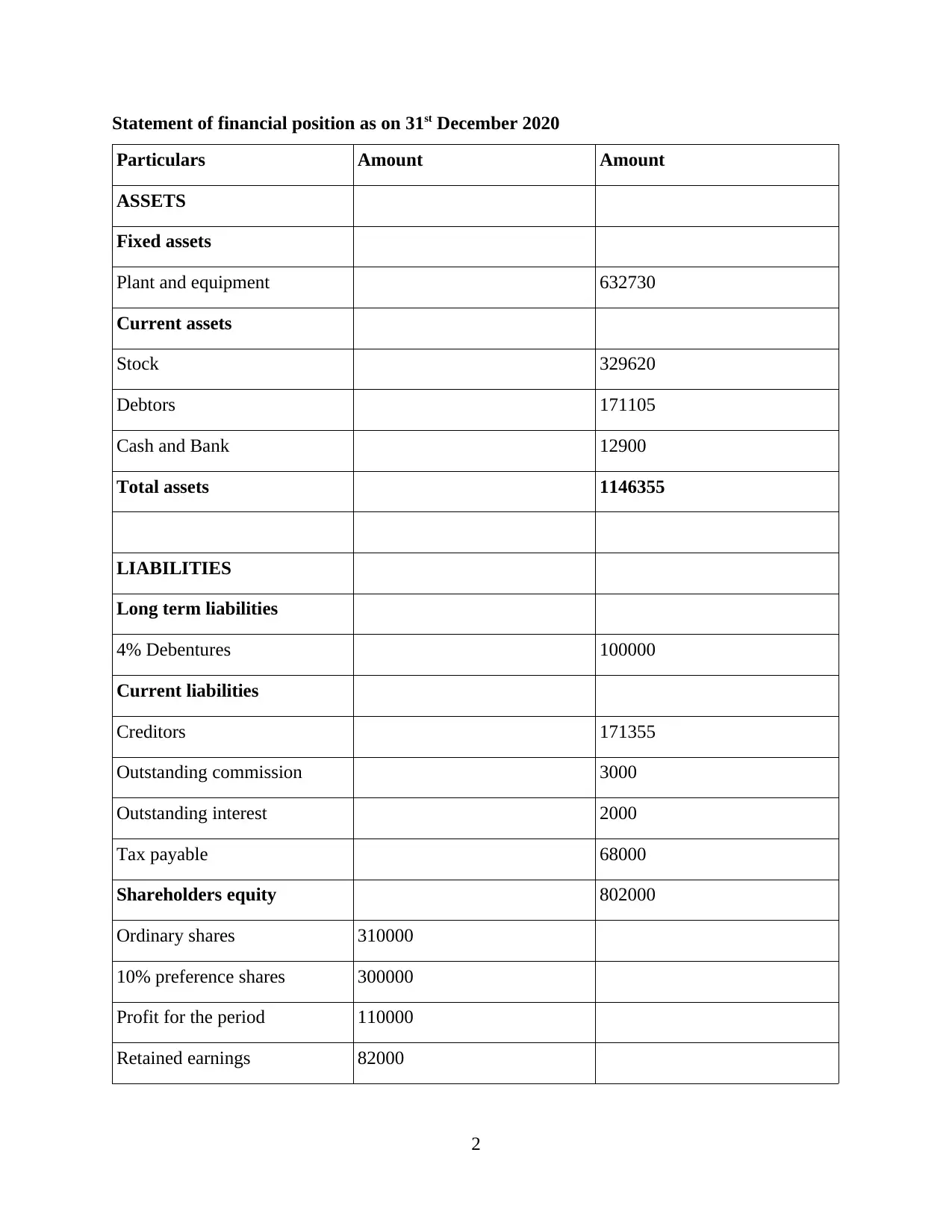
Statement of financial position as on 31st December 2020
Particulars Amount Amount
ASSETS
Fixed assets
Plant and equipment 632730
Current assets
Stock 329620
Debtors 171105
Cash and Bank 12900
Total assets 1146355
LIABILITIES
Long term liabilities
4% Debentures 100000
Current liabilities
Creditors 171355
Outstanding commission 3000
Outstanding interest 2000
Tax payable 68000
Shareholders equity 802000
Ordinary shares 310000
10% preference shares 300000
Profit for the period 110000
Retained earnings 82000
2
Particulars Amount Amount
ASSETS
Fixed assets
Plant and equipment 632730
Current assets
Stock 329620
Debtors 171105
Cash and Bank 12900
Total assets 1146355
LIABILITIES
Long term liabilities
4% Debentures 100000
Current liabilities
Creditors 171355
Outstanding commission 3000
Outstanding interest 2000
Tax payable 68000
Shareholders equity 802000
Ordinary shares 310000
10% preference shares 300000
Profit for the period 110000
Retained earnings 82000
2
Paraphrase This Document
Need a fresh take? Get an instant paraphrase of this document with our AI Paraphraser
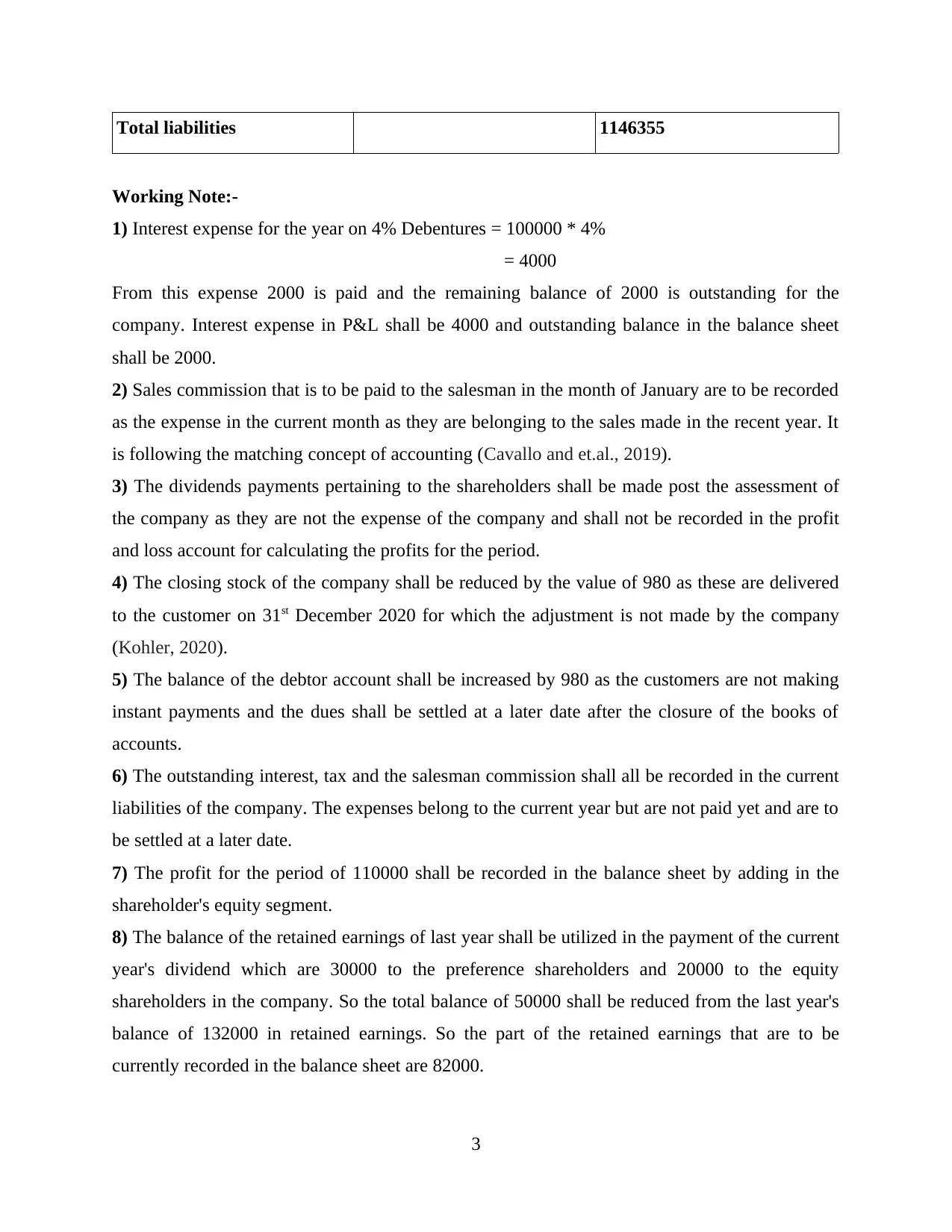
Total liabilities 1146355
Working Note:-
1) Interest expense for the year on 4% Debentures = 100000 * 4%
= 4000
From this expense 2000 is paid and the remaining balance of 2000 is outstanding for the
company. Interest expense in P&L shall be 4000 and outstanding balance in the balance sheet
shall be 2000.
2) Sales commission that is to be paid to the salesman in the month of January are to be recorded
as the expense in the current month as they are belonging to the sales made in the recent year. It
is following the matching concept of accounting (Cavallo and et.al., 2019).
3) The dividends payments pertaining to the shareholders shall be made post the assessment of
the company as they are not the expense of the company and shall not be recorded in the profit
and loss account for calculating the profits for the period.
4) The closing stock of the company shall be reduced by the value of 980 as these are delivered
to the customer on 31st December 2020 for which the adjustment is not made by the company
(Kohler, 2020).
5) The balance of the debtor account shall be increased by 980 as the customers are not making
instant payments and the dues shall be settled at a later date after the closure of the books of
accounts.
6) The outstanding interest, tax and the salesman commission shall all be recorded in the current
liabilities of the company. The expenses belong to the current year but are not paid yet and are to
be settled at a later date.
7) The profit for the period of 110000 shall be recorded in the balance sheet by adding in the
shareholder's equity segment.
8) The balance of the retained earnings of last year shall be utilized in the payment of the current
year's dividend which are 30000 to the preference shareholders and 20000 to the equity
shareholders in the company. So the total balance of 50000 shall be reduced from the last year's
balance of 132000 in retained earnings. So the part of the retained earnings that are to be
currently recorded in the balance sheet are 82000.
3
Working Note:-
1) Interest expense for the year on 4% Debentures = 100000 * 4%
= 4000
From this expense 2000 is paid and the remaining balance of 2000 is outstanding for the
company. Interest expense in P&L shall be 4000 and outstanding balance in the balance sheet
shall be 2000.
2) Sales commission that is to be paid to the salesman in the month of January are to be recorded
as the expense in the current month as they are belonging to the sales made in the recent year. It
is following the matching concept of accounting (Cavallo and et.al., 2019).
3) The dividends payments pertaining to the shareholders shall be made post the assessment of
the company as they are not the expense of the company and shall not be recorded in the profit
and loss account for calculating the profits for the period.
4) The closing stock of the company shall be reduced by the value of 980 as these are delivered
to the customer on 31st December 2020 for which the adjustment is not made by the company
(Kohler, 2020).
5) The balance of the debtor account shall be increased by 980 as the customers are not making
instant payments and the dues shall be settled at a later date after the closure of the books of
accounts.
6) The outstanding interest, tax and the salesman commission shall all be recorded in the current
liabilities of the company. The expenses belong to the current year but are not paid yet and are to
be settled at a later date.
7) The profit for the period of 110000 shall be recorded in the balance sheet by adding in the
shareholder's equity segment.
8) The balance of the retained earnings of last year shall be utilized in the payment of the current
year's dividend which are 30000 to the preference shareholders and 20000 to the equity
shareholders in the company. So the total balance of 50000 shall be reduced from the last year's
balance of 132000 in retained earnings. So the part of the retained earnings that are to be
currently recorded in the balance sheet are 82000.
3
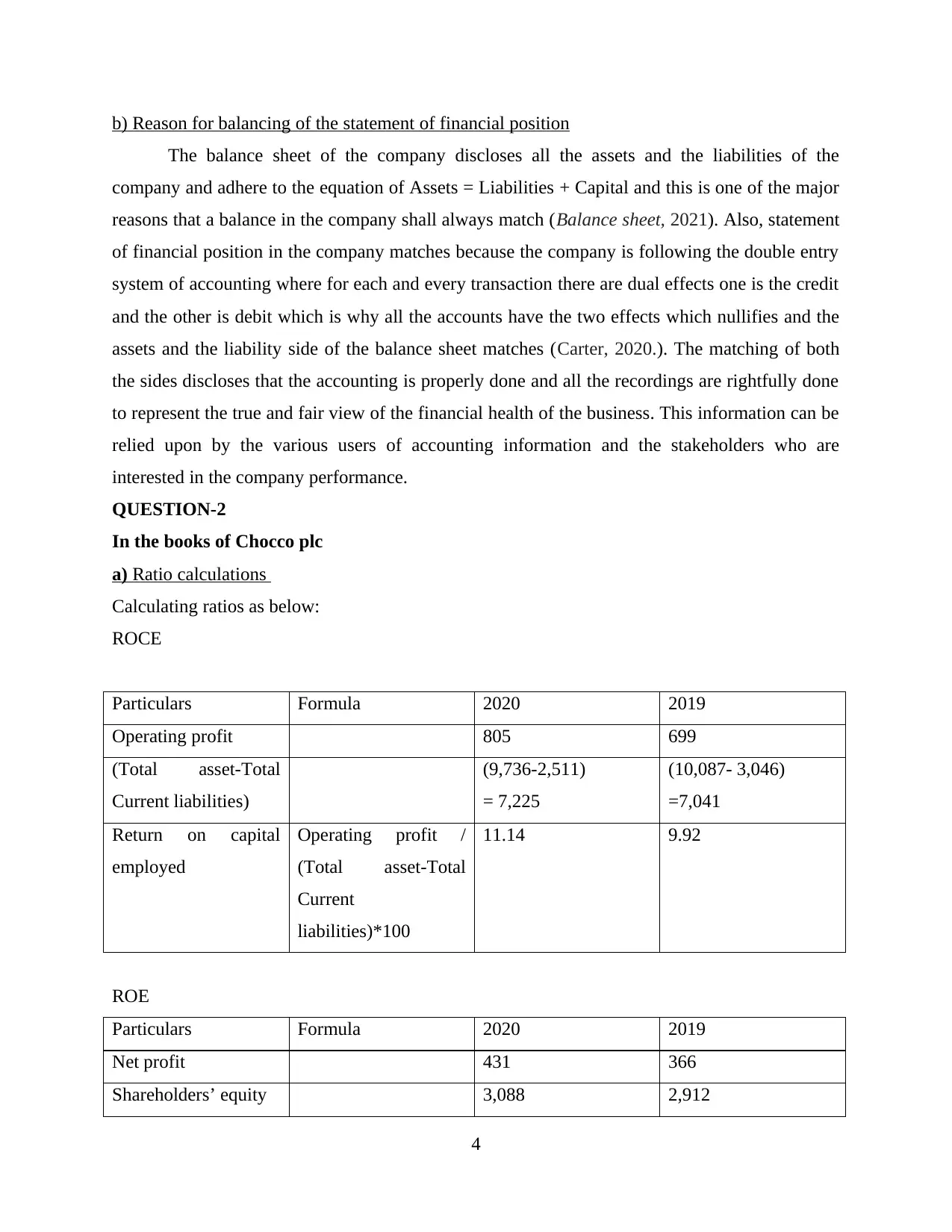
b) Reason for balancing of the statement of financial position
The balance sheet of the company discloses all the assets and the liabilities of the
company and adhere to the equation of Assets = Liabilities + Capital and this is one of the major
reasons that a balance in the company shall always match (Balance sheet, 2021). Also, statement
of financial position in the company matches because the company is following the double entry
system of accounting where for each and every transaction there are dual effects one is the credit
and the other is debit which is why all the accounts have the two effects which nullifies and the
assets and the liability side of the balance sheet matches (Carter, 2020.). The matching of both
the sides discloses that the accounting is properly done and all the recordings are rightfully done
to represent the true and fair view of the financial health of the business. This information can be
relied upon by the various users of accounting information and the stakeholders who are
interested in the company performance.
QUESTION-2
In the books of Chocco plc
a) Ratio calculations
Calculating ratios as below:
ROCE
Particulars Formula 2020 2019
Operating profit 805 699
(Total asset-Total
Current liabilities)
(9,736-2,511)
= 7,225
(10,087- 3,046)
=7,041
Return on capital
employed
Operating profit /
(Total asset-Total
Current
liabilities)*100
11.14 9.92
ROE
Particulars Formula 2020 2019
Net profit 431 366
Shareholders’ equity 3,088 2,912
4
The balance sheet of the company discloses all the assets and the liabilities of the
company and adhere to the equation of Assets = Liabilities + Capital and this is one of the major
reasons that a balance in the company shall always match (Balance sheet, 2021). Also, statement
of financial position in the company matches because the company is following the double entry
system of accounting where for each and every transaction there are dual effects one is the credit
and the other is debit which is why all the accounts have the two effects which nullifies and the
assets and the liability side of the balance sheet matches (Carter, 2020.). The matching of both
the sides discloses that the accounting is properly done and all the recordings are rightfully done
to represent the true and fair view of the financial health of the business. This information can be
relied upon by the various users of accounting information and the stakeholders who are
interested in the company performance.
QUESTION-2
In the books of Chocco plc
a) Ratio calculations
Calculating ratios as below:
ROCE
Particulars Formula 2020 2019
Operating profit 805 699
(Total asset-Total
Current liabilities)
(9,736-2,511)
= 7,225
(10,087- 3,046)
=7,041
Return on capital
employed
Operating profit /
(Total asset-Total
Current
liabilities)*100
11.14 9.92
ROE
Particulars Formula 2020 2019
Net profit 431 366
Shareholders’ equity 3,088 2,912
4
⊘ This is a preview!⊘
Do you want full access?
Subscribe today to unlock all pages.

Trusted by 1+ million students worldwide
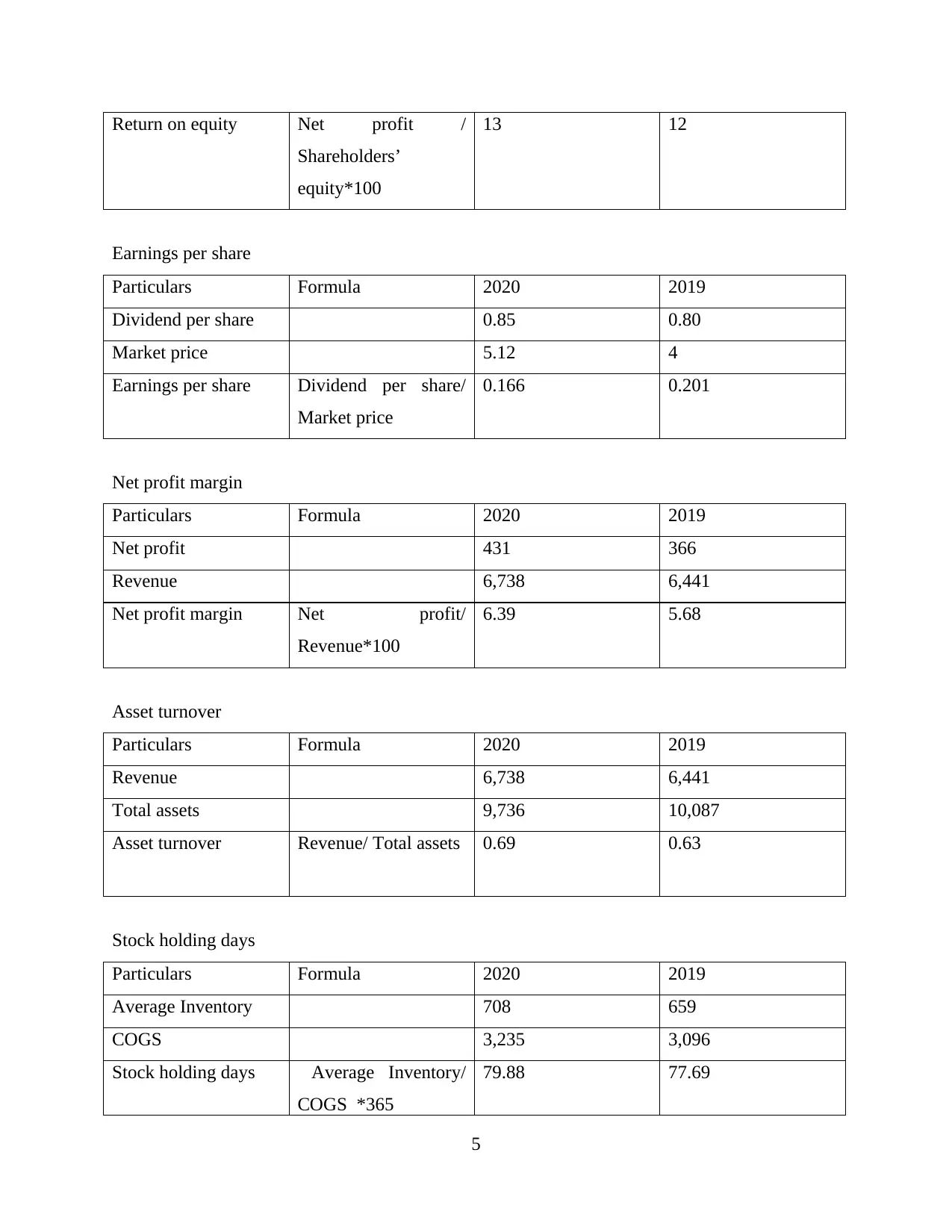
Return on equity Net profit /
Shareholders’
equity*100
13 12
Earnings per share
Particulars Formula 2020 2019
Dividend per share 0.85 0.80
Market price 5.12 4
Earnings per share Dividend per share/
Market price
0.166 0.201
Net profit margin
Particulars Formula 2020 2019
Net profit 431 366
Revenue 6,738 6,441
Net profit margin Net profit/
Revenue*100
6.39 5.68
Asset turnover
Particulars Formula 2020 2019
Revenue 6,738 6,441
Total assets 9,736 10,087
Asset turnover Revenue/ Total assets 0.69 0.63
Stock holding days
Particulars Formula 2020 2019
Average Inventory 708 659
COGS 3,235 3,096
Stock holding days Average Inventory/
COGS *365
79.88 77.69
5
Shareholders’
equity*100
13 12
Earnings per share
Particulars Formula 2020 2019
Dividend per share 0.85 0.80
Market price 5.12 4
Earnings per share Dividend per share/
Market price
0.166 0.201
Net profit margin
Particulars Formula 2020 2019
Net profit 431 366
Revenue 6,738 6,441
Net profit margin Net profit/
Revenue*100
6.39 5.68
Asset turnover
Particulars Formula 2020 2019
Revenue 6,738 6,441
Total assets 9,736 10,087
Asset turnover Revenue/ Total assets 0.69 0.63
Stock holding days
Particulars Formula 2020 2019
Average Inventory 708 659
COGS 3,235 3,096
Stock holding days Average Inventory/
COGS *365
79.88 77.69
5
Paraphrase This Document
Need a fresh take? Get an instant paraphrase of this document with our AI Paraphraser

Debtors collection period
Particulars Formula 2020 2019
Trade receivables 1,249 1,287
Sales 6,738 6,441
Debtors collection
period
Trade receivables/
Sales*365
67.65 72.93
Current ratio
Particulars Formula 2020 2019
Current assets 2,303 2,355
Current liabilities 2,511 3,046
Current ratio Current assets /
Current liabilities
0.92 0.77
Gearing ratio
Particulars Formula 2020 2019
Total Debt 6,648 7,175
Total equity 3,088 2,912
Gearing ratio Total Debt/ Total
equity
2.15 2.46
Inventory turnover ratio
Particulars Formula 2020 2019
COGS 3,235 3,096
Average inventory 708 659
Inventory turnover
ratio
COGS/ Average
inventory
4.5 5.44
6
Particulars Formula 2020 2019
Trade receivables 1,249 1,287
Sales 6,738 6,441
Debtors collection
period
Trade receivables/
Sales*365
67.65 72.93
Current ratio
Particulars Formula 2020 2019
Current assets 2,303 2,355
Current liabilities 2,511 3,046
Current ratio Current assets /
Current liabilities
0.92 0.77
Gearing ratio
Particulars Formula 2020 2019
Total Debt 6,648 7,175
Total equity 3,088 2,912
Gearing ratio Total Debt/ Total
equity
2.15 2.46
Inventory turnover ratio
Particulars Formula 2020 2019
COGS 3,235 3,096
Average inventory 708 659
Inventory turnover
ratio
COGS/ Average
inventory
4.5 5.44
6
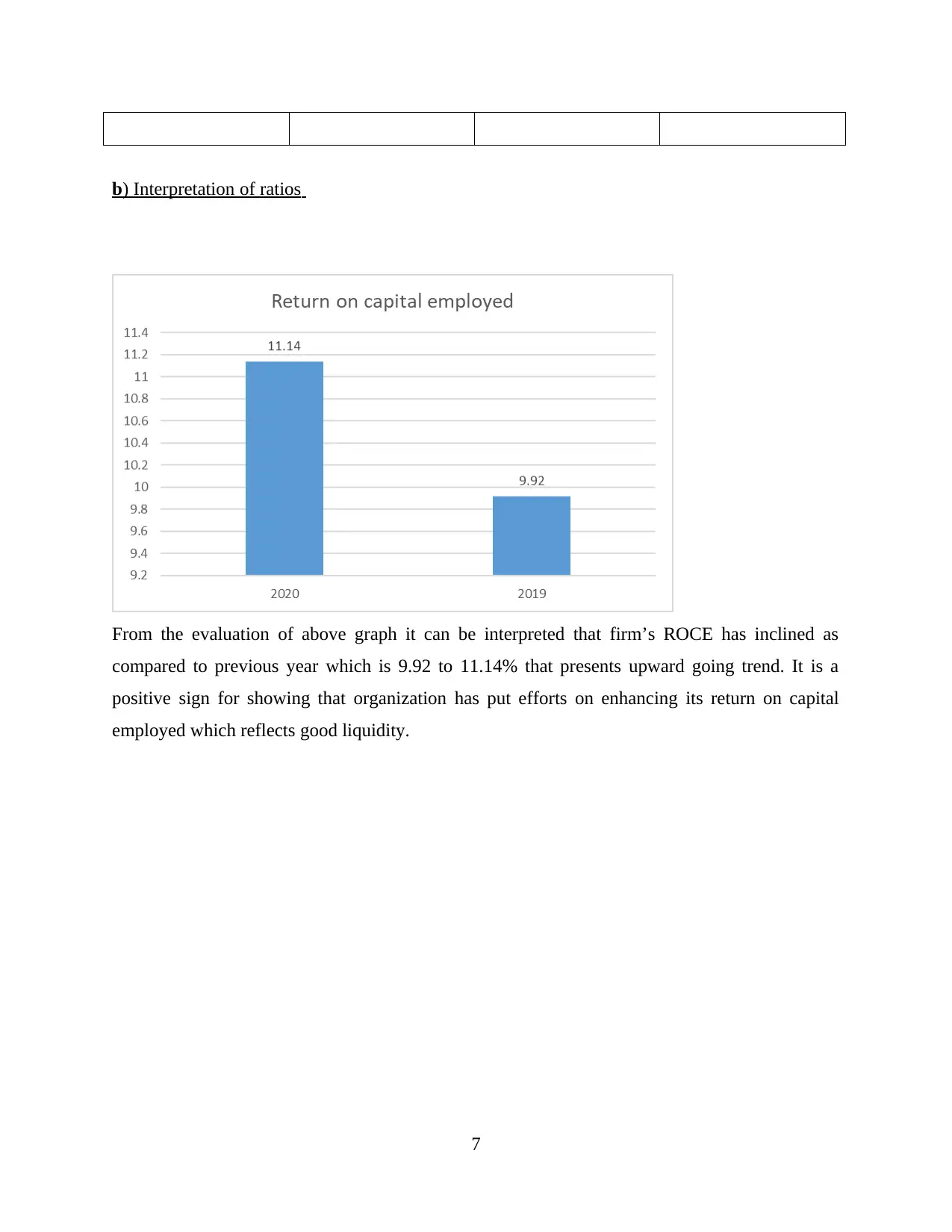
b) Interpretation of ratios
From the evaluation of above graph it can be interpreted that firm’s ROCE has inclined as
compared to previous year which is 9.92 to 11.14% that presents upward going trend. It is a
positive sign for showing that organization has put efforts on enhancing its return on capital
employed which reflects good liquidity.
7
From the evaluation of above graph it can be interpreted that firm’s ROCE has inclined as
compared to previous year which is 9.92 to 11.14% that presents upward going trend. It is a
positive sign for showing that organization has put efforts on enhancing its return on capital
employed which reflects good liquidity.
7
⊘ This is a preview!⊘
Do you want full access?
Subscribe today to unlock all pages.

Trusted by 1+ million students worldwide
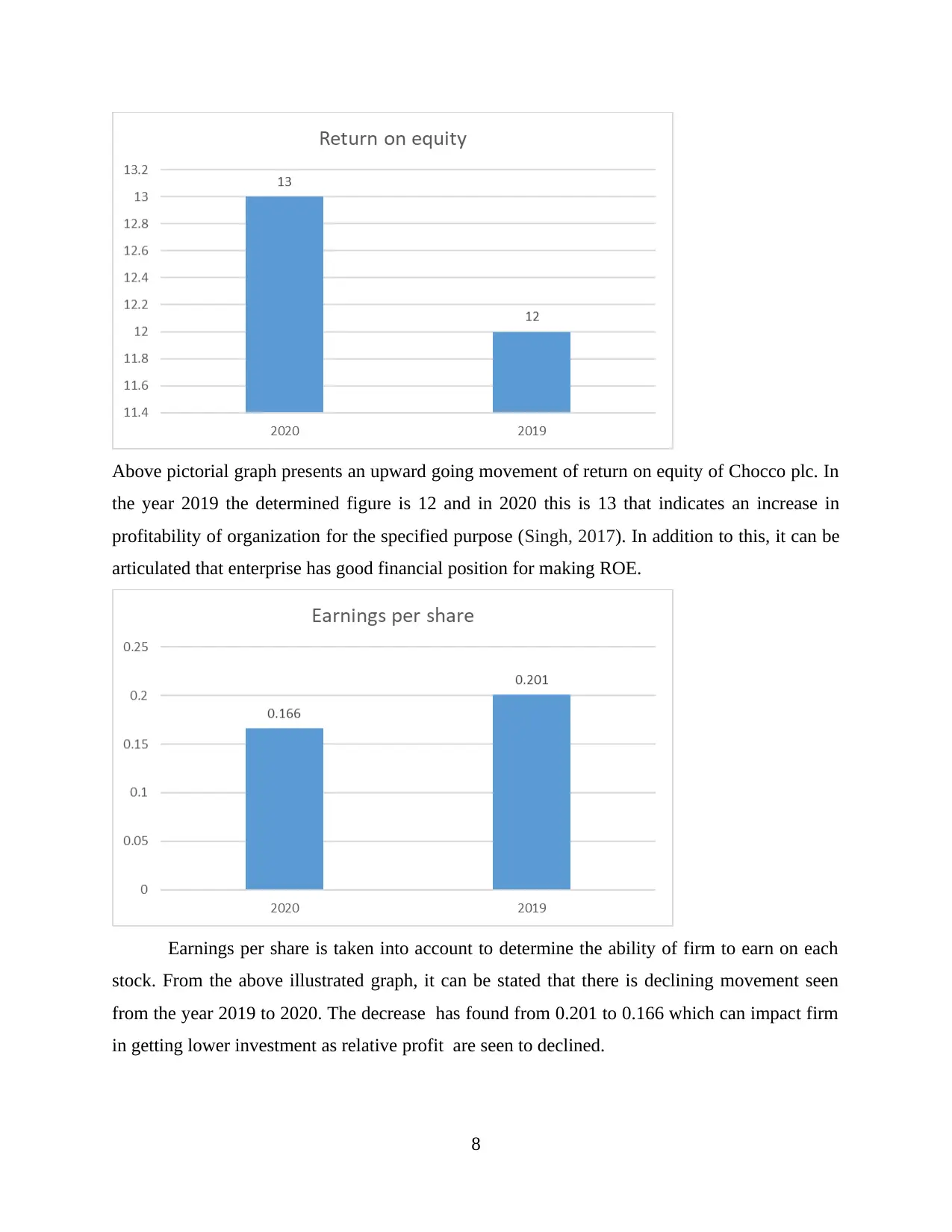
Above pictorial graph presents an upward going movement of return on equity of Chocco plc. In
the year 2019 the determined figure is 12 and in 2020 this is 13 that indicates an increase in
profitability of organization for the specified purpose (Singh, 2017). In addition to this, it can be
articulated that enterprise has good financial position for making ROE.
Earnings per share is taken into account to determine the ability of firm to earn on each
stock. From the above illustrated graph, it can be stated that there is declining movement seen
from the year 2019 to 2020. The decrease has found from 0.201 to 0.166 which can impact firm
in getting lower investment as relative profit are seen to declined.
8
the year 2019 the determined figure is 12 and in 2020 this is 13 that indicates an increase in
profitability of organization for the specified purpose (Singh, 2017). In addition to this, it can be
articulated that enterprise has good financial position for making ROE.
Earnings per share is taken into account to determine the ability of firm to earn on each
stock. From the above illustrated graph, it can be stated that there is declining movement seen
from the year 2019 to 2020. The decrease has found from 0.201 to 0.166 which can impact firm
in getting lower investment as relative profit are seen to declined.
8
Paraphrase This Document
Need a fresh take? Get an instant paraphrase of this document with our AI Paraphraser
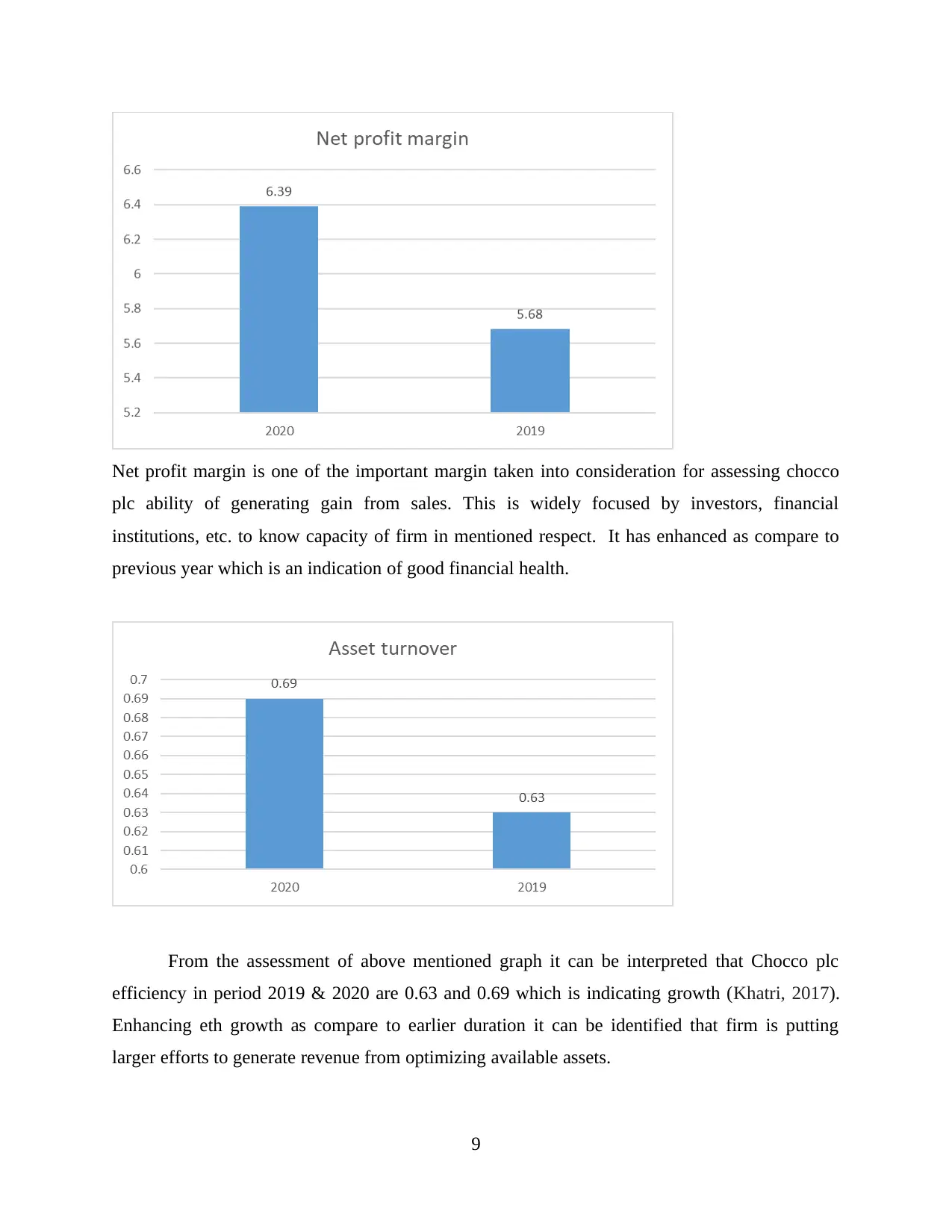
Net profit margin is one of the important margin taken into consideration for assessing chocco
plc ability of generating gain from sales. This is widely focused by investors, financial
institutions, etc. to know capacity of firm in mentioned respect. It has enhanced as compare to
previous year which is an indication of good financial health.
From the assessment of above mentioned graph it can be interpreted that Chocco plc
efficiency in period 2019 & 2020 are 0.63 and 0.69 which is indicating growth (Khatri, 2017).
Enhancing eth growth as compare to earlier duration it can be identified that firm is putting
larger efforts to generate revenue from optimizing available assets.
9
plc ability of generating gain from sales. This is widely focused by investors, financial
institutions, etc. to know capacity of firm in mentioned respect. It has enhanced as compare to
previous year which is an indication of good financial health.
From the assessment of above mentioned graph it can be interpreted that Chocco plc
efficiency in period 2019 & 2020 are 0.63 and 0.69 which is indicating growth (Khatri, 2017).
Enhancing eth growth as compare to earlier duration it can be identified that firm is putting
larger efforts to generate revenue from optimizing available assets.
9
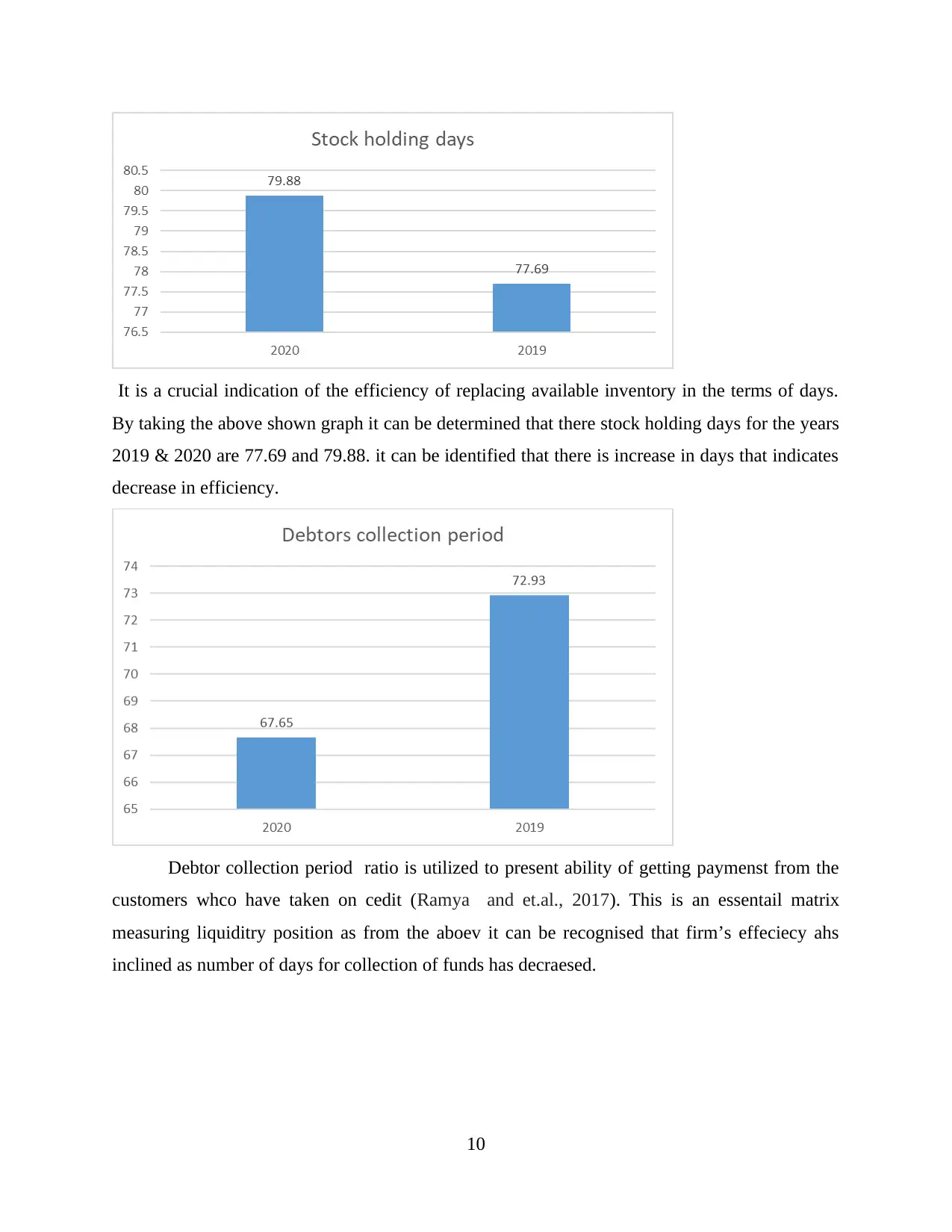
It is a crucial indication of the efficiency of replacing available inventory in the terms of days.
By taking the above shown graph it can be determined that there stock holding days for the years
2019 & 2020 are 77.69 and 79.88. it can be identified that there is increase in days that indicates
decrease in efficiency.
Debtor collection period ratio is utilized to present ability of getting paymenst from the
customers whco have taken on cedit (Ramya and et.al., 2017). This is an essentail matrix
measuring liquiditry position as from the aboev it can be recognised that firm’s effeciecy ahs
inclined as number of days for collection of funds has decraesed.
10
By taking the above shown graph it can be determined that there stock holding days for the years
2019 & 2020 are 77.69 and 79.88. it can be identified that there is increase in days that indicates
decrease in efficiency.
Debtor collection period ratio is utilized to present ability of getting paymenst from the
customers whco have taken on cedit (Ramya and et.al., 2017). This is an essentail matrix
measuring liquiditry position as from the aboev it can be recognised that firm’s effeciecy ahs
inclined as number of days for collection of funds has decraesed.
10
⊘ This is a preview!⊘
Do you want full access?
Subscribe today to unlock all pages.

Trusted by 1+ million students worldwide
1 out of 15
Related Documents
Your All-in-One AI-Powered Toolkit for Academic Success.
+13062052269
info@desklib.com
Available 24*7 on WhatsApp / Email
![[object Object]](/_next/static/media/star-bottom.7253800d.svg)
Unlock your academic potential
Copyright © 2020–2025 A2Z Services. All Rights Reserved. Developed and managed by ZUCOL.





